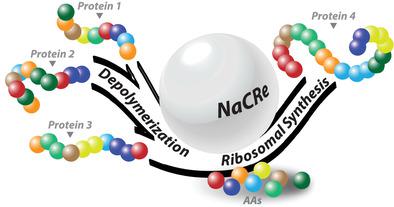当前位置:
X-MOL 学术
›
Adv. Mater.
›
论文详情
Our official English website, www.x-mol.net, welcomes your
feedback! (Note: you will need to create a separate account there.)
Nature-Inspired Circular-Economy Recycling for Proteins: Proof of Concept
Advanced Materials ( IF 27.4 ) Pub Date : 2021-09-23 , DOI: 10.1002/adma.202104581 Simone Giaveri 1, 2 , Adeline Marie Schmitt 1, 3 , Laura Roset Julià 1 , Vincenzo Scamarcio 1 , Anna Murello 1 , Shiyu Cheng 2 , Laure Menin 4 , Daniel Ortiz 4 , Luc Patiny 4 , Sreenath Bolisetty 5 , Raffaele Mezzenga 5, 6 , Sebastian Josef Maerkl 2 , Francesco Stellacci 1, 2
Advanced Materials ( IF 27.4 ) Pub Date : 2021-09-23 , DOI: 10.1002/adma.202104581 Simone Giaveri 1, 2 , Adeline Marie Schmitt 1, 3 , Laura Roset Julià 1 , Vincenzo Scamarcio 1 , Anna Murello 1 , Shiyu Cheng 2 , Laure Menin 4 , Daniel Ortiz 4 , Luc Patiny 4 , Sreenath Bolisetty 5 , Raffaele Mezzenga 5, 6 , Sebastian Josef Maerkl 2 , Francesco Stellacci 1, 2
Affiliation

|
The billion tons of synthetic-polymer-based materials (i.e. plastics) produced yearly are a great challenge for humanity. Nature produces even more natural polymers, yet they are sustainable. Proteins are sequence-defined natural polymers that are constantly recycled when living systems feed. Digestion is the protein depolymerization into amino acids (the monomers) followed by their re-assembly into new proteins of arbitrarily different sequence and function. This breaks a common recycling paradigm where a material is recycled into itself. Organisms feed off of random protein mixtures that are “recycled” into new proteins whose identity depends on the cell's specific needs. In this study, mixtures of several peptides and/or proteins are depolymerized into their amino acid constituents, and these amino acids are used to synthesize new fluorescent, and bioactive proteins extracellularly by using an amino-acid-free, cell-free transcription–translation (TX–TL) system. Specifically, three peptides (magainin II, glucagon, and somatostatin 28) are digested using thermolysin first and then using leucine aminopeptidase. The amino acids so produced are added to a commercial TX–TL system to produce fluorescent proteins. Furthermore, proteins with high relevance in materials engineering (β-lactoglobulin films, used for water filtration, or silk fibroin solutions) are successfully recycled into biotechnologically relevant proteins (fluorescent proteins, catechol 2,3-dioxygenase).
中文翻译:

受自然启发的蛋白质循环经济回收:概念验证
每年生产的数十亿吨合成聚合物材料(即塑料)对人类来说是一个巨大的挑战。大自然生产出更多的天然聚合物,但它们是可持续的。蛋白质是序列定义的天然聚合物,在生命系统进食时不断循环利用。消化是将蛋白质解聚成氨基酸(单体),然后将其重新组装成具有任意不同序列和功能的新蛋白质。这打破了一种常见的回收范例,即材料被回收成自身。生物体以随机蛋白质混合物为食,这些蛋白质混合物被“回收”成新蛋白质,其特性取决于细胞的特定需求。在这项研究中,几种肽和/或蛋白质的混合物被解聚成它们的氨基酸成分,并且这些氨基酸通过使用无氨基酸、无细胞的转录-翻译在细胞外合成新的荧光和生物活性蛋白质(TX-TL)系统。具体而言,首先使用嗜热菌蛋白酶消化三种肽(magainin II、胰高血糖素和生长抑素28),然后使用亮氨酸氨肽酶消化。将如此产生的氨基酸添加到商业 TX-TL 系统中以产生荧光蛋白。此外,与材料工程高度相关的蛋白质(用于水过滤的β-乳球蛋白膜或丝素蛋白溶液)被成功回收为生物技术相关的蛋白质(荧光蛋白、儿茶酚2,3-双加氧酶)。
更新日期:2021-11-01
中文翻译:

受自然启发的蛋白质循环经济回收:概念验证
每年生产的数十亿吨合成聚合物材料(即塑料)对人类来说是一个巨大的挑战。大自然生产出更多的天然聚合物,但它们是可持续的。蛋白质是序列定义的天然聚合物,在生命系统进食时不断循环利用。消化是将蛋白质解聚成氨基酸(单体),然后将其重新组装成具有任意不同序列和功能的新蛋白质。这打破了一种常见的回收范例,即材料被回收成自身。生物体以随机蛋白质混合物为食,这些蛋白质混合物被“回收”成新蛋白质,其特性取决于细胞的特定需求。在这项研究中,几种肽和/或蛋白质的混合物被解聚成它们的氨基酸成分,并且这些氨基酸通过使用无氨基酸、无细胞的转录-翻译在细胞外合成新的荧光和生物活性蛋白质(TX-TL)系统。具体而言,首先使用嗜热菌蛋白酶消化三种肽(magainin II、胰高血糖素和生长抑素28),然后使用亮氨酸氨肽酶消化。将如此产生的氨基酸添加到商业 TX-TL 系统中以产生荧光蛋白。此外,与材料工程高度相关的蛋白质(用于水过滤的β-乳球蛋白膜或丝素蛋白溶液)被成功回收为生物技术相关的蛋白质(荧光蛋白、儿茶酚2,3-双加氧酶)。











































 京公网安备 11010802027423号
京公网安备 11010802027423号